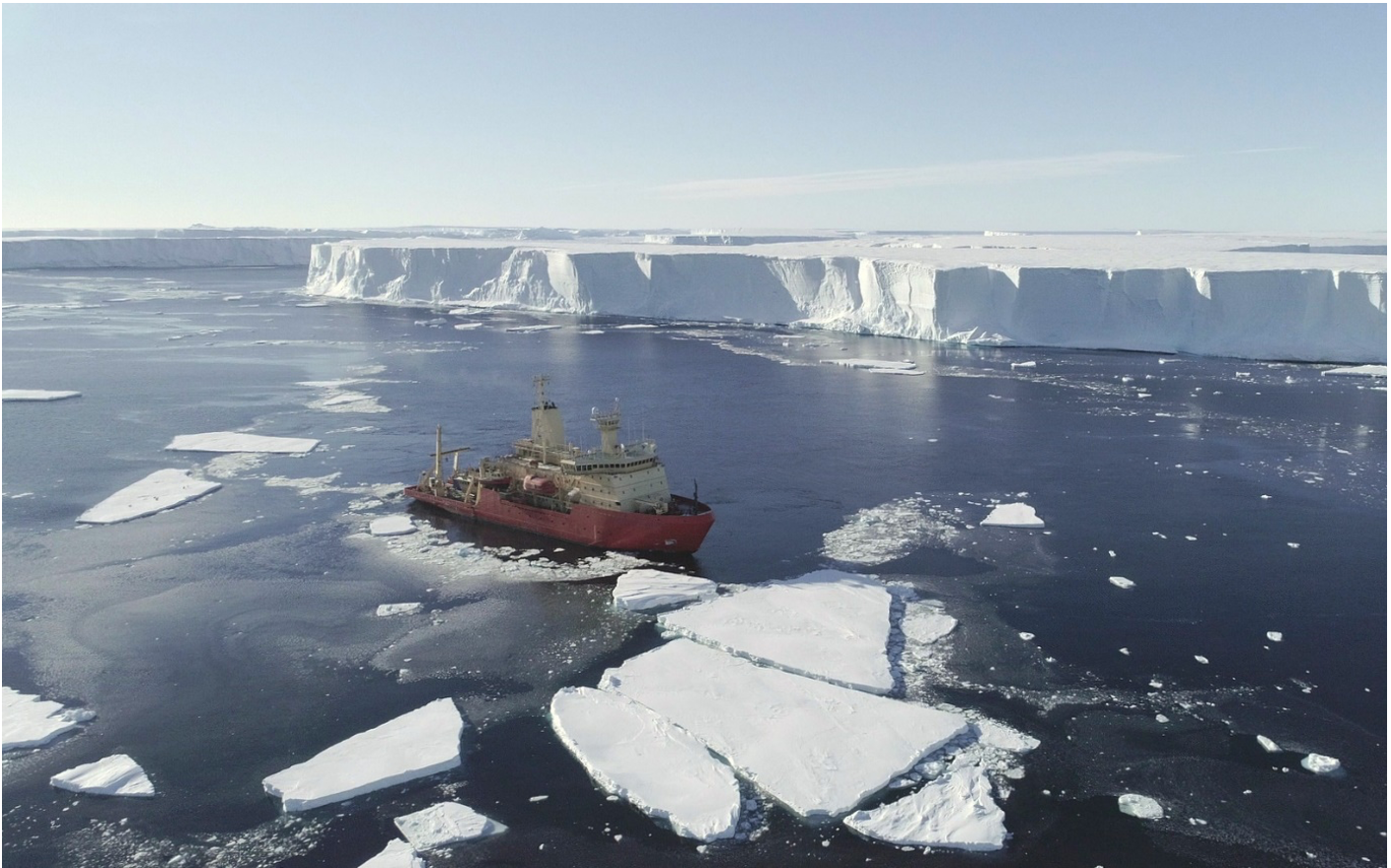
For the first time, researchers have collected data from underneath the remote Thwaites Glacier in West Antarctica using an underwater robot. Findings reveal that the supply of warm water to the glacier is larger than previously thought, triggering concerns of faster melting and accelerating ice flow. The findings are published this week (10 April 2021) in the journal Science Advances.
An autonomous submarine called Ran was deployed under Thwaites glacier in 2019. The submersible measured the strength, temperature, salinity and oxygen content of the ocean currents that penetrate under the glacier.
“These were the first measurements ever performed beneath the ice front of Thwaites glacier. Global sea level is affected by how much ice there is on land, and the biggest uncertainty in the forecasts is the future evolution of the West Antarctic Ice Sheet”, says lead author Professor Anna Wåhlin, professor of oceanography at the University of Gothenburg.
Professor Karen Heywood of the University of East Anglia, a Principal Investigator on the TARSAN project of the International Thwaites Glacier Collaboration (ITGC), says:
“This was Ran’s first venture to polar regions and her exploration of the waters under the ice shelf was much more successful than we had dared to hope. We plan to build on these exciting findings with further missions under the ice next year."
The ice sheet in West Antarctica accounts for about ten percent of the current rate of sea level rise, but ice in West Antarctica holds the most potential for increasing that rate because the fastest changes are taking place at Thwaites Glacier. Due to its location and shape, Thwaites is particularly sensitive to warm and salty ocean currents that are accessing beneath.
The results have been used to map the ocean currents underneath the floating part of the glacier. One exciting result is the team discovered there is a deep connection to the east through which deep water flows from Pine Island Bay, a connection that was previously thought to be blocked by an underwater ridge.
The team also measured the heat transport in one of the three channels that lead warm water towards Thwaites Glacier from the north.
“The channels for warm water to access and attack Thwaites weren’t known to us before the research. Using sonars on the ship, nested with very high-resolution ocean mapping from Ran, we were able to find that there are distinct paths that water takes in and out of the ice shelf cavity, influenced by the geometry of the ocean floor,” says Dr. Alastair Graham, from the University of Southern Florida.
The researchers also noted that large amounts of meltwater flowed north away from the front of the glacier. Variations in salinity, temperature and oxygen content indicate that the area under the glacier is a previously unknown active area where different water masses meet and mix with each other, which is important for understanding the melting processes at the base of the ice.
The observations show warm water approaching from all sides on pinning points, critical locations where the ice is connected to the seabed and give stability to the ice shelf. Melting around these pinning points may lead to instability and retreat of the ice shelf and, subsequently, the upstream glacier flowing off the land.
Dr. Rob Larter, a geophysicist from British Antarctic Survey, who’s a Principal Investigator on the THOR project of ITGC, accompanied the science cruise to Thwaites Glacier in early 2019. He says:
"This work highlights that how and where warm water impacts Thwaites Glacier is influenced by the shape of the sea floor and the ice-shelf base as well as the properties of the water itself. The successful integration of new sea-floor survey data and observations of water properties from the Ran missions shows the benefits of the multidisciplinary ethos within the International Thwaites Glacier Collaboration."
"The good news is that we are now, for the first time, collecting data that will enable us to model the dynamics of Thwaite's glacier. This data will help us better calculate ice melting in the future. With the help of new technology, we can improve the models and reduce the great uncertainty that now prevails around global sea level variations,” concludes lead author Professor Wåhlin.
Pathways and modification of warm water flowing beneath Thwaites Ice Shelf, West Antarctica by A. K. Wåhlin, A. Graham, K. A. Hogan, B. Y. Queste, L. Boehme, R. Larter, E. Pettit, J. Wellner, K. J. Heywood is published in the journal Science Advances.
Ends
Contact details:
Anna Wåhlin, University of Gothenburg, Sweden.
Phone: +46 766 182866 email: anna.wahlin@gu.se
Alastair G.C. Graham, University of South Florida, USA
Phone: +1 727 569 6416 email: alastairg@usf.edu
Kelly Hogan, British Antarctic Survey, UK
Phone: +44 (0) 1223 221617 email: kelgan@bas.ac.uk
Bastien Y. Queste, University of Gothenburg, Sweden.
Phone: +46 73 504 28 39 email: bastien.queste@marine.gu.se
Lars Boehme
Phone: +44 (0)1334 462677 email: lb284@st-andrews.ac.uk
Robert D. Larter, British Antarctic Survey, UK
Phone: +44 1223 221573 email: rdla@bas.ac.uk
Erin Petit, Oregon State University, USA
Phone: +1 (541)-737-0942 email: pettiter@oregonstate.edu
Julia Wellner, University of Houston, USA
Phone: +1 (713) 743-2887 email: jwellner@uh.edu
Karen Heywood, University of East Anglia, UK
email: communications@uea.ac.uk






